Copyright by Lawrence R. Gustin 1973, 1984, 2008
Published by the University of Michigan Press 2008
All rights reserved
Published in the United States of America by
The University of Michigan Press
Manufactured in the United States of America
 Printed on acid-free paper
Printed on acid-free paper
No part of this publication may be reproduced, stored in a retrieval system, or transmitted in any form or by any means, electronic, mechanical, or otherwise, without the written permission of the publisher.
Illustrations on pages 13, 5, 6, and 9 by Steve Clack.
Update
A line in this book says the importance of William C. Durant's career will undoubtedly be appreciated more fully some day. And in the decades since Billy Durant was first published in 1973, that certainly has happenedparticularly in Flint, Michigan, where his accomplishments were most obvious.
Six weeks after the first edition was published, Flint Mayor Paul C. Visser proclaimed the week of Durant's birthdate, December 8, as William Crapo Durant Week in Flint. Durant's widow, Catherine, was thrilled to receive the proclamation, which came just in time. She died in New York January 19, 1974.
Some Durant-inspired initiatives were temporary. Billy's Pub in downtown Flint, decorated with pictures of Durant and his wife Catherine, opened in 1984 but closed a few years later. A downtown Billy Durant Festival came and went.
Some were permanent. The decrepit Durant-Dort Carriage Company office buildingscheduled to be razed before a newspaper campaign helped save itis today restored and a National Historic Landmark. This was where Durant had his Flint office before Buick came to town: It's considered virtually the birthplace of General Motors. The three-story brick building is now listed on the National Register of Historic Places and also adorned with a Michigan historical marker. Nearby, state historical markers in Flint's Carriage Town point out the restored Flint Road Cart Company factory and the home of Charles W. Nash when he was superintendent of Durant-Dort, before he became president of GM and then Nash Motors.
When Michigan sculptor Derek Wernher created a life-size bronze statue of Durant (later to be joined by one of his partner, Dallas Dort) and officials had it erected on his 127th birthday (December 8, 1988) within sight of the Durant-Dort headquarters, its unveiling was witnessed by a GM vice president, two Durant grandchildren, four Durant great-grandchildren, and the New York Times. Also, banker Robert J. Whaley's home near downtown Flint has been restored and holds the original Flint Road Cart Company bank book showing the 1886 deposits of $1,000 each by Durant and Dortthe earliest document in GM's prehistory. Flint's Sloan Museum displays a mannequin of Durant; holds many of his papers and photos; and, in partnership with Buick, has opened a Buick Gallery and Research Center nearby. Across town, Durant papers used for the earlier editions of this book are housed at Kettering University. A horse barn that stood behind the Durants' Flint home (and was for years owned by the parents of the author's childhood friend Janet Gardner) has been saved and moved to nearby Historical Crossroads Village.
But much has been lost. By GM's centennial year, the best monuments toDurant in Flint, as listed in the main text, were mostly gone. No more Fisher Body. AC Spark Plug became a fading Delphi East. The huge Buick home complexthe foundation of GM's creation in 1908was closed in 1999 and most of its vast collection of factories virtually scraped away early in the new millennium. The last remaining significant activity at the site is final production of Buick 3800 V-6 engines (Buick engine production in Flint has surpassed 100 years). A complex of Chevrolet plants disappeared as well, though Chevy trucks still rolled off one local assembly line.

An attempt to tell Flint's automobile story with a 1980s theme park named AutoWorld was artistically creative but financially a disaster and was soon ridiculed, imploded, and bulldozed. In 1978, about 78,000 people were employed by Flint-area GM plants. In 2008, it was under 9,000 and dropping.
But what Durant created or saved had legs on the larger stage. Buick and Cadillac have celebrated their centennials (and Oldsmobile did too before its poorly handled execution). Chevrolet is a dominant brand. GMC trucks live, as do the Pontiac cars that grew from Oakland Motor Car Company. General Motors is still at the top in salesbarelyof all the world automakers. It's fitting that Durant's name as GM's founder is cast in bronze on a Michigan historical marker in front of the corporation's new headquarters in downtown Detroit, because neither GM nor its most famous American marques would likely exist today had he not either created or saved them. No wonder the Society of Automotive Historians ranked William C. Durant No. 2, behind only Henry Ford, on its list of the 30 most significant auto pioneers.
Billy Durant appears here almost exactly as in the first and second editions, which means some references are dated. GM no longer occupies the GM Building mentioned in the Prologue, but has moved to Renaissance Center on the Detroit River downtown. General Motors Institute, or GMI, is now Kettering University. No Buicks are built in Flint; indeed more are built in China than in the entire United States. And one other change is worth noting: Billy Durant, as a historical figure, is no longer the forgotten man.
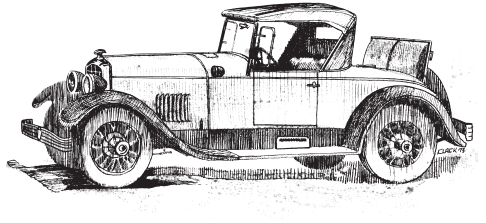
Foreword
This account of the career of William Crapo Durant is based in part on unpublished manuscripts and documents and on interviews with his widow, two of his personal secretaries and others who knew him well.
Among the manuscripts used extensively are Durant's own autobiographical notes. This manuscript of seven short typewritten chapters, plus scattered notes, is not always accurate-much of it was written in the 1930s and 1940s, decades after the events describedbut it contains valuable information and some insights into Durant's motives. These notes, and numerous letters and other personal papers, were made available to the writer by Durant's widow, Mrs. Catherine Durant, with the cooperation of his last personal secretary, Aristo Scrobogna, who is the legal custodian of Durant's papers.
Durant is best remembered in Flint, Michigan, a city which owes practically all of its large industrial baseand its historical distinction of being the birthplace of General Motorsto his accomplishments. And the manuscript which really provided the basis for this account is a 600-page Industrial History of Flint which was compiled by Frank M. Rodolf in the early 1940s when he was a reporter and librarian for The Flint Journal. It is surely one of the best and most complete accounts of Durant's career ever compiled. Rodolf, who left The Journal shortly after the manuscript was completed, was located by the writer in New York City. With his permission, and that of

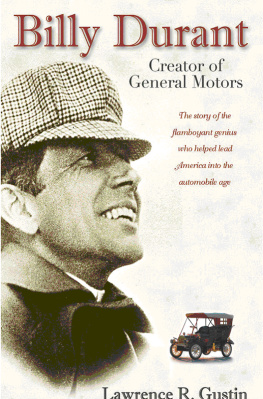



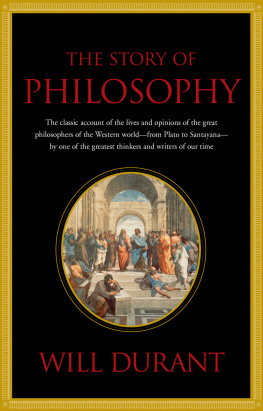


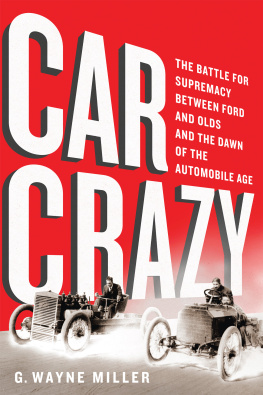

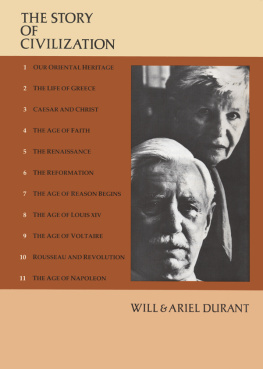



 Printed on acid-free paper
Printed on acid-free paper
